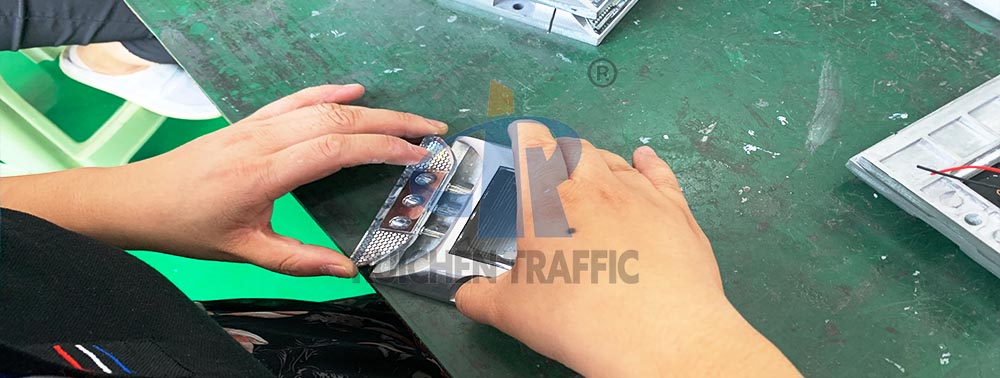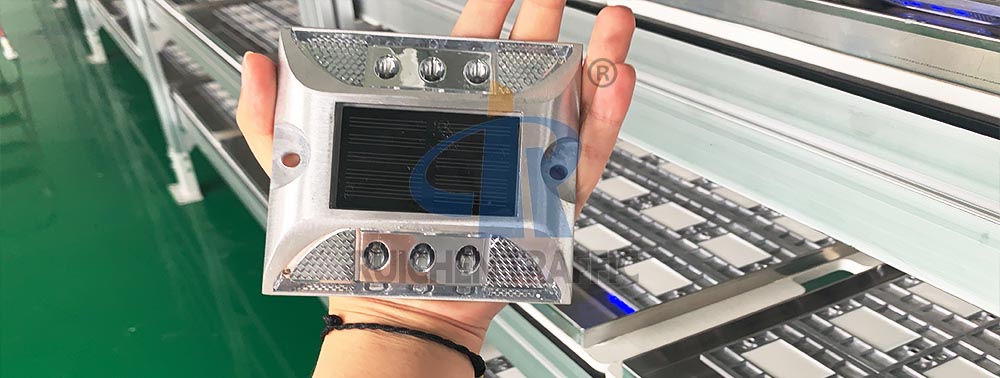1. Photoelectric conversion and energy storage
Solar panels:
Solar Road Studs are equipped with high-efficiency solar panels on top or at specific locations. These panels can absorb sunlight and convert it into electrical energy.
Energy storage device: The converted electrical energy is stored in a built-in battery or supercapacitor for use by LED lights at night or when there is insufficient light.
2. Intelligent perception and judgment
Photosensitive sensor: The photosensitive sensor detects changes in ambient light intensity. When night falls or the light intensity is lower than the set threshold, the LED light is automatically started for lighting.
Temperature sensor: Some high-end
Solar Road Studs are also equipped with temperature sensors to monitor ambient temperature so as to intelligently adjust the brightness or working mode of the LED lights to meet the needs of use in different seasons and climate conditions.

Other sensors (such as geomagnetic induction, radar, etc.): Some advanced
Solar Road Studs also integrate geomagnetic induction, radar and other sensors to detect the driving status and position of vehicles on the road, thereby achieving more accurate traffic guidance and early warning functions.
3. Microcontroller and intelligent algorithm
Microcontroller:
Solar Road Studs is embedded with a microcontroller (MCU) as the core control unit of the entire system. The microcontroller is responsible for receiving signals from various sensors and processing and judging them according to the preset intelligent algorithm.
Intelligent algorithm: The intelligent algorithm is embedded in the microcontroller through programming to realize real-time monitoring and intelligent analysis of multiple parameters such as light intensity, temperature, and vehicle driving status. According to the analysis results, the microcontroller can automatically adjust parameters such as the brightness, color or flashing frequency of the LED light to provide lighting and traffic guidance effects that are more in line with actual needs.

4. Wireless communication and remote control
Wireless communication module: Some
Solar Road Studs are also equipped with wireless communication modules (such as Wi-Fi, Bluetooth, Zigbee, etc.) to enable them to communicate with remote monitoring centers or other intelligent devices.
Remote control function: Through the wireless communication module, managers can monitor and remotely control
Solar Road Studs in real time at the remote monitoring center. For example, the working mode, brightness setting, or fault diagnosis of Solar Road Studs can be adjusted as needed.
5. Intelligent application scenarios
Lane outline:
Solar Road Studs can display the outline of lane lines in a constant or flashing form at night, improving the driver's recognition of lane boundaries.
Vehicle detection and warning: Combined with geomagnetic induction, radar and other sensor technologies,
Solar Road Studs can achieve real-time detection of vehicles on the road, and send warning information to the driver by changing color, flashing frequency and other methods when potential safety hazards are detected.

Data statistics and analysis: By collecting and analyzing the working data of
Solar Road Studs, it can provide important road condition information and decision support for traffic management departments, which helps to optimize road layout and traffic management strategies.
In summary,
Solar Road Studs realizes intelligent traffic guidance and lighting functions by integrating advanced technical means such as photoelectric conversion, energy storage, intelligent perception and judgment, microcontrollers and intelligent algorithms, as well as wireless communication and remote control. These intelligent features make
Solar Road Studs have significant advantages in improving road safety, reducing energy consumption and reducing maintenance costs.


